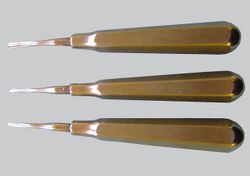Engineering:Coupland's elevators
Coupland's elevators (also known as chisels)[1][2] are instruments commonly used for dental extraction. They are used in sets of three each of increasing size and are used to split multi-rooted teeth and are inserted between the bone and tooth roots and rotated to elevate them out of the sockets.[3] The instruments were designed by Dr Douglas C W Coupland who qualified as a dental surgeon in Toronto in 1922 and spent most of his career practising dentistry in Ottawa where he specialised in dental extraction.[4] Coupland designed the instruments in the 1920s; they were manufactured by the Hu-Friedy company and sold from the early 1930s initially as sets of eight or twelve which were later reduced to three.[2] Coupland also designed a set of dental suckers with interchangeable tips.[2]
References
- ↑ Bussell, MA; Graham, RM (November 2008). "The history of some commonly used dental elevators". British Dental Journal 205 (9): 505–508. doi:10.1038/sj.bdj.2008.933. PMID 18997710.
- ↑ 2.0 2.1 2.2 Cove, Peter (24 January 2009). "Coupland's Chisels". British Dental Journal 206 (2): 57. doi:10.1038/sj.bdj.2009.16. PMID 19165247.
- ↑ Robinson, Paul (2000). Tooth Extraction: A Practical Guide. Oxford: Butterworth-Heinemann. ISBN 978-0723610717.
- ↑ "Obituary". Journal of the Canadian Dental Association. 1936.
 |


